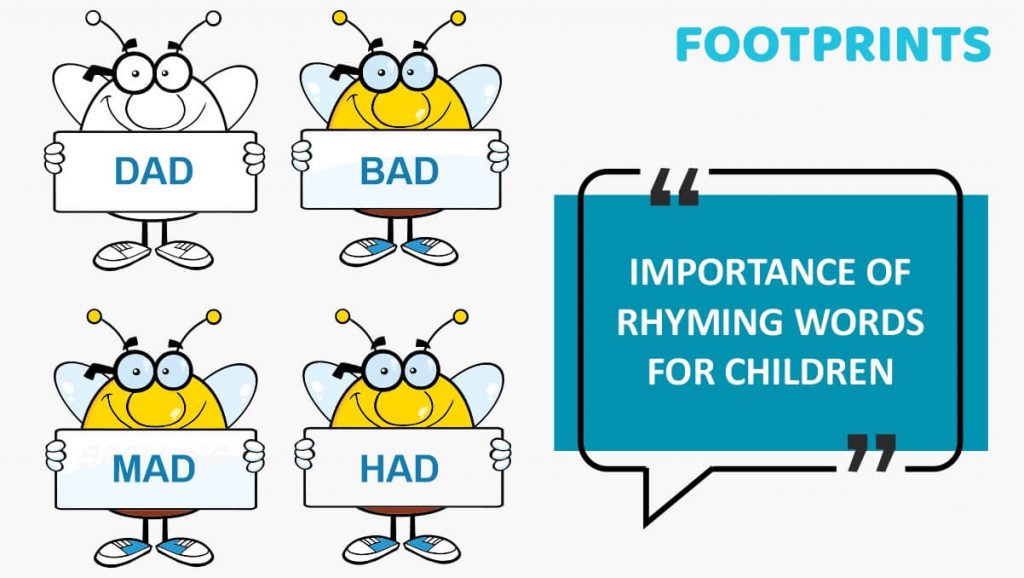

“Jack and Jill
Went up the hill.
To fetch a pail of water
Jack fell down.
And broke his crown.
And Jill came tumbling after.”
How often have you recited this poem as a child or even helped your children repeat it? This rhyme, along with several others, contains rhyming words – words with similar endings. While we may not ascribe too much value to them, rhyming words help enhance verbal skills. Researchers have found a strong connection between the ability to recognize rhyming words and reading proficiency. In other words, good rhymers often turn out to be good readers. Another crucial aspect of it is their aid in memory and retention.
At Footprints, a play school that has emerged as an effective parenting partner, we harness the power of rhyming words to help children advance their verbal skills and reading journey.
Let’s explore the benefits of rhyming words for children in more detail:
1. Add fun to reading
The inclusion of rhyming words significantly enhances the fun of reading. These catchy rhymes will spark a child’s curiosity and help them enjoy reading rather than considering it a chore.
Importantly, rhyming is an essential first step toward phonemic awareness, which involves recognizing that words consist of individual sounds. When children listen to rhyming words, they listen to sounds within words. This, in turn, assists them in identifying word parts and subsequently combining them to form words.
2. Enhance pronunciation and vocabulary
With exposure to rhyming words and the ability to recognize that separate sounds come together to form a word, another aspect that improves is the child’s pronunciation. Rhyming words also contribute to the child’s verbal skills. The greater the exposure to rhyming words, the more enriched the child’s vocabulary becomes.
3. Improve Retention
Interestingly, rhyming words also help the child remember and retain information easily.
4. Enhance imagination
Rhyming songs, poems, and more enable the child to create a vivid mental image accompanying the rhyme. This, in turn, significantly enhances the child’s imagination.
Children typically learn rhymes in 3 stages:
The first stage is when you expose them to rhymes and rhyming words. The second stage is when they memorize these rhymes and, in turn, make associations and integrate these associations into long-term memory. The third stage is when the child uses this stored knowledge to create rhyming words independently.
Now that we understand the advantages of rhyming words and their stages.
Let’s explore some activities you can engage in to help your child learn rhyming words:
1. Fun Games
You can create fun games in which you come up with words and ask the children to, for example, jump three times if their name rhymes with the word you called out, or if they own something that rhymes with the word you called out. Your imagination is the only limit in this game. The child develops their rhyming and motor skills in this enjoyable game. It’s also a great bonding exercise.
Another option is to play rhyming games such as “I say night, you say right,” where, in response to the word you provide, the child has to offer a rhyming word.
2. Fun Bag
You can create a fun bag containing several small objects. The children take turns picking up two objects, preferably blindfolded. They must then determine if the two objects they picked rhyme. If they do rhyme, the child gets another turn; otherwise, it moves on to the next child.
Alternatively, you can set a time limit for the children, during which they must pull out as many rhyming objects as possible.
3. Rhyming word books
Rhyming word books are another way to introduce the child to new words while having a lot of fun. You can take turns reading out rhyming words.
4. Music and songs
There isn’t a better way to teach rhyming words than through music and songs. Songs that invite movement are a favorite with children.
5. Reading aloud
You could read aloud to the child and intersperse the reading with fun activities, such as:
- Asking the child to raise their hand when they hear rhyming words.
- Stopping without warning and getting the child to supply a rhyming word.
6. Make your nursery rhymes
This is sure to be a fun activity. The way it works is that you start a nursery rhyme by providing one line. Then, the child must add the following line with a rhyming word. After a couple of rounds, you’ll have your own nursery rhyme.
To simplify your task, we have also compiled some frequently used three- and four-letter rhyming words that will be useful!
Three-Letter Rhyming Words
| Bug | Jug | Mug | Hug |
| Hip | Lip | Dip | Sip |
| Car | Far | Bar | Jar |
| Can | Fan | Man | Pan |
| Dad | Bad | Mad | Had |
| Top | Cop | Mop | Pop |
| Cub | Hub | Rub | Tub |
| Nut | But | Hut | Cut |
Four-letter rhyming words
| Ball | Blab | Crop |
| Hall | Drab | Shop |
| Wall | Flab | Clop |
| Tall | Crab | Plop |
Here’s to a lot of fun and games as you use rhyming words to help enhance the child’s verbal ability.

